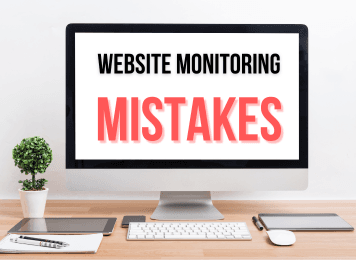In today’s digital landscape, website monitoring is crucial for businesses to maintain optimal performance, security, and user satisfaction. However, many organizations overlook certain essential aspects, leading to downtime, sluggish performance, and negative user experiences. In this article, we’ll explore the top 10 critical website monitoring mistakes and provide actionable advice on avoiding them to keep your site running smoothly and efficiently.
10 Critical Website Monitoring Mistakes and How to Prevent Them
Iliya Timohin
2024-11-01

10 Critical Website Monitoring Mistakes and How to Prevent Them
1. Not Monitoring All Critical Pages
Many businesses focus solely on their homepage or a handful of pages, missing out on monitoring other critical areas of the site. This oversight can lead to undetected issues in essential user journeys, such as login, checkout, or contact pages. A failed login process, for instance, can disrupt user access, while checkout page issues can result in lost revenue.
Solution: Create a comprehensive monitoring plan that covers all crucial pages. Use transaction monitoring to track user journeys, ensuring every critical step functions as expected.
2. Using a Single Monitoring Location
Monitoring your site from only one geographic location can give you a skewed view of performance. Issues like latency or connectivity often vary by region, so relying on a single location could hide problems that affect users in specific areas.
Solution: Employ a multi-location monitoring approach to gain a global view of your site’s performance. Many monitoring tools offer this feature, allowing you to catch regional issues early.
3. Infrequent Monitoring Intervals
Performing checks at long intervals may miss short periods of downtime or performance issues that happen between monitoring points. This lack of frequency can lead to undetected issues that affect user experience.
Solution: Increase the frequency of your monitoring intervals to provide near real-time data. Adjust the frequency based on traffic patterns and the criticality of the monitored pages to ensure you catch any issues promptly.
4. Ignoring SSL Expiry and Security Issues
SSL certificates are vital for security and trust, yet many businesses forget to monitor SSL expiry dates and potential security vulnerabilities. An expired SSL certificate can disrupt user access, damage SEO, and erode customer trust.
Solution: Set up automated alerts to notify you well before an SSL certificate expires. In addition, use vulnerability scanning tools to regularly check for security threats.
5. Neglecting Mobile Performance Monitoring
As mobile devices account for a significant share of web traffic, overlooking mobile performance can lead to a subpar experience for mobile users. Ignoring mobile monitoring might mean missing issues specific to mobile browsing, such as load times or layout problems.
Solution: Integrate mobile monitoring into your website monitoring strategy. Tools that simulate mobile device performance can help you identify and resolve mobile-specific issues.
6. Not Tracking Uptime and Downtime Separately
Tracking uptime and downtime together can give an inaccurate picture of your site’s availability and reliability. Without separate metrics, it’s hard to understand the real impact of downtime on user experience and business goals.
Solution: Separate uptime and downtime metrics to gain a clear view of your site’s availability. By tracking these independently, you can identify patterns and make improvements to maximize uptime.
7. Overlooking Server Response Time
Focusing solely on uptime without considering server response time can be damaging. A slow server response time may not be technically “downtime,” but it can still result in a poor user experience and affect your site’s SEO ranking.
Solution: Include server response time in your monitoring routine. Many tools provide server response metrics, enabling you to ensure your site loads quickly and efficiently for users.
8. Ignoring Key Transactions Monitoring
Important user actions, like purchasing or submitting forms, need to be consistently monitored to ensure seamless functionality. Failure in these key transactions can lead to user frustration and significant revenue losses.
Solution: Use transaction monitoring to verify that essential actions work as expected. Set up workflows to simulate and test key user interactions on a regular basis.
9. No Alert Prioritization
When every alert has the same level of importance, it’s easy to become overwhelmed by minor issues while missing more urgent ones. A lack of prioritization can result in critical problems going unaddressed.
Solution: Implement a tiered alert system that classifies alerts based on severity. Prioritizing critical alerts helps your team focus on the most urgent matters, reducing downtime and performance issues.
10. Not Testing for User Experience
Monitoring uptime alone doesn’t reveal the full user experience. Factors like page load time, navigation ease, and interactive elements play a significant role in shaping user satisfaction. Without testing these elements, you may overlook crucial experience-related issues.
Solution: Perform regular user experience (UX) testing to simulate real user interactions and detect any issues affecting the user journey. Many monitoring tools offer synthetic monitoring, which simulates user behavior and provides insights into the overall user experience.
Conclusion
Website monitoring is essential for optimal performance and reliability, but common mistakes can undermine its effectiveness. By avoiding these 10 critical monitoring errors, you can enhance your site’s performance, ensure security, and provide a better user experience. Regularly review and refine your monitoring strategy to keep pace with evolving needs, ensuring your site remains accessible, responsive, and trustworthy for all users.
10 Critical Website Monitoring Mistakes and How to Prevent Them
1. Not Monitoring All Critical Pages
2. Using a Single Monitoring Location
3. Infrequent Monitoring Intervals
4. Ignoring SSL Expiry and Security Issues
5. Neglecting Mobile Performance Monitoring
6. Not Tracking Uptime and Downtime Separately
7. Overlooking Server Response Time
8. Ignoring Key Transactions Monitoring
9. No Alert Prioritization
10. Not Testing for User Experience
Conclusion